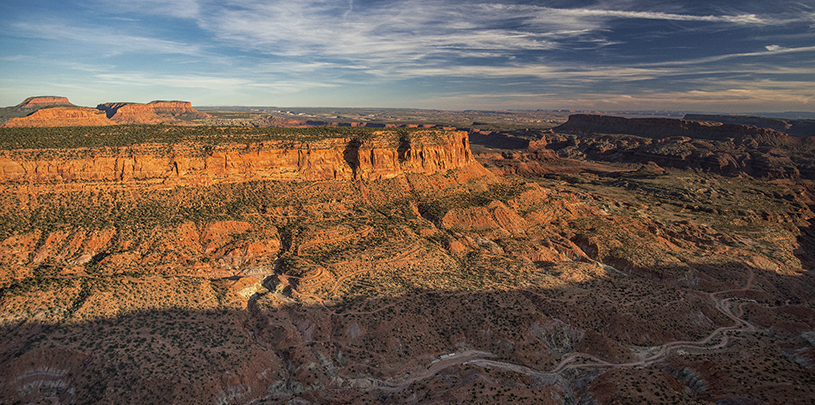 by Tim Peterson, Cultural Landscapes Director
by Tim Peterson, Cultural Landscapes Director
UPDATE: On October 8, 2021, President Biden restored full protections to Bears Ears and Grand Staircase-Escalante national monuments. Send a personal note of thanks to President Biden ›
There’s an old joke in southern Utah: “How do you know when it’s finally spring? The license plates turn green.” But neighboring Coloradoans and their green plates weren’t the only ones headed to Utah this April. Deb Haaland visited Utah on her first official trip as interior secretary. She was the third secretary in five years to visit the state to mull the question of national monuments, their management, and their size.
“I’m here to listen.”
Secretary Haaland’s visit was different from those of former secretaries Jewell and Zinke in style and in substance, but also in terms of public engagement. COVID-19 protocols meant no public events, only one press conference, and strict size limits on meetings.
Contrasting starkly with former Secretary Zinke’s visit in 2017, Secretary Haaland’s trip indicated a genuine interest in gathering differing perspectives. She took the time to meet with all sides and left even opponents seemingly satisfied with her receptivity.
“My message is really very simple, I’m here to listen, I’m here to learn,” Secretary Haaland said in a press conference on April 8. “I know that decisions about public lands are incredibly impactful to the people who live nearby. But not just to us, not just to the folks who are here today, but [for] people for generations to come…So it’s important that the president get this right,” she continued.
The visit was different from a personal perspective as well. As the first Indigenous interior secretary, Secretary Haaland understands the enduring cultural value of the monuments. Her ancestral connections to these places made her experience different.
The earth holds so much power. We must all work together to honor it.
Photo at Valley of the Gods, Bears Ears #Utah pic.twitter.com/Y1FymyF7ti
— Secretary Deb Haaland (@SecDebHaaland) April 8, 2021
A busy schedule
Secretary Haaland arrived in Bluff, Utah mid-day on April 7. She toured the Sand Island petroglyph site with land managers, visited the Bears Ears Education Center, then met with tribal leaders, and later, with Utah elected officials, including Governor Cox, Rep. Curtis, Rep. Moore, and Senator Romney.
On April 8, she attended a morning ceremony with local spiritual leaders and Indigenous elected officials near Muley Point, and toured Bears Ears with tribal leaders and Utah elected officials. That afternoon she held a press conference, then three stakeholder meetings in Blanding, one with local elected officials, one with ranching and mining interests, and one with conservationists.
On April 9, Secretary Haaland flew to Kanab and met with Reps. Stewart and Owens, Senator Mike Lee, and county commissioners, as well as a meeting with conservation and business interests.
The Trust was fortunate to attend the conservation stakeholder listening session in Blanding. Collectively, the group focused on support for expanding Bears Ears to the full 1.9 million acres originally proposed by tribes. Individually, I used my three minutes to urge restoration for Grand Staircase-Escalante and expansion of Bears Ears and restoration of our landmark deal limiting cattle grazing in the Escalante River canyons. I showed photos of areas that were proposed by the Bears Ears Inter-Tribal Coalition but not included in the 2016 Bears Ears designation, and spoke to the importance of collaborative management. I also emphasized that everyone has a story to tell about Bears Ears, even those who may consider themselves opponents.
Opposition hardens
However, after the secretary’s visit, the Utah delegation seemed to harden its opposition to restoring the monuments using the Antiquities Act, renewing demands that Utah be exempted from further presidential national monument designations. According to a joint statement from the delegation: “without protections against the Antiquities Act, Utah is left vulnerable to the whim of future presidents.” Such an unpopular provision is unlikely to pass congressional muster.
National monuments are widely popular across the political spectrum, with 77 percent of Westerners and 74 percent of Utahns favoring restoration in a recent poll.
Digging in, Governor Cox said Utah will likely sue should President Biden act to restore the monuments, but legal scholar and Grand Canyon Trust Board Trustee John Leshy argues that the governor “is wrong to argue that the Supreme Court is likely to reverse any restoration of Utah’s national monuments.”
Mr. President, the time to act is now
It’s important that Bears Ears and Grand Staircase-Escalante are restored quickly. Especially considering four new mining claims were filed in March and April 2021 on lands unlawfully cut from Bears Ears in 2017. One claim is next to the Easy Peasy Mine, and the other three just north of Natural Bridges National Monument. All were filed by the same uranium miner that excavated the Easy Peasy Mine in 2018. If for some reason restoration doesn’t come soon, it’s important that the Department of the Interior institute a mineral withdrawal now to prevent more mining claims.
Thank you!
A hearty thanks to all who participated in the online day of action on April 9, 2021. Collectively, we reached over 5.5 million people on Twitter and Instagram with the hashtags #SaveGrandStaircase and #StandWithBearsEars.
After all the anticipation and excitement around the visit, we can take great hope and comfort in the fact that with new leadership in charge, the future looks bright for Bears Ears and Grand Staircase-Escalante.
This has been a meaningful trip, and I deeply appreciate the many people who took the time to share their wisdom, perspectives, and prayers with me. It’s a powerful reminder that how we manage public lands and national monuments will provide a path for future generations. pic.twitter.com/1FMbTmpS3S
— Secretary Deb Haaland (@SecDebHaaland) April 9, 2021





